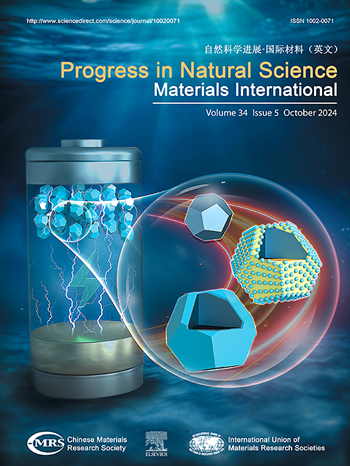Unlocking Co3O4–ZnO p-n heterojunction for superior acetone gas sensing detection
IF 4.8
2区 材料科学
Q2 MATERIALS SCIENCE, MULTIDISCIPLINARY
Progress in Natural Science: Materials International
Pub Date : 2024-10-01
DOI:10.1016/j.pnsc.2024.07.014
引用次数: 0
Abstract
In this study, we synthesized pure ZnO and Co3O4–ZnO precursors with varied Co, Zn ratios via solvothermal method, and then the precursors were calcined at 400 °C for 2 h in a muffle furnace under air to obtain composites for acetone detection. The structure, morphology, elemental composition, microstructure and chemical state of these materials were systematically studied by various characterization techniques. Additionally, we also evaluated the gas sensing performance of the composites-based sensors, focusing on optimal operating temperature, baseline resistance, repeatability, stability, selectivity, response/recovery time, and resistance under varying relative humidity. The findings reveal that 3 % Co3O4–ZnO-based sensor exhibit the highest response value to 100 ppm acetone (74), showing an enhancement of approximately 9.3 times compared to the pure ZnO-based sensor (8). Furthermore, the 3 % Co3O4–ZnO-based sensor demonstrate the advantages of rapid response/recovery times (15 s/2 s), outstanding selectivity, and remarkable stability. The gas sensing mechanism of the composite material is also discussed in detail, which provides insights into the observed enhancement of gas sensing performance. It provides an idea for the follow-up study on gas sensing performance of acetone sensors.
揭开 Co3O4-ZnO p-n 异质结的神秘面纱,实现卓越的丙酮气体传感检测功能
在本研究中,我们通过溶热法合成了纯 ZnO 和不同 Co、Zn 比例的 Co3O4-ZnO 前驱体,然后在马弗炉中于空气中于 400 °C 煅烧 2 小时,得到了用于丙酮检测的复合材料。我们利用各种表征技术系统地研究了这些材料的结构、形态、元素组成、微观结构和化学状态。此外,我们还评估了基于复合材料的传感器的气体传感性能,重点是最佳工作温度、基线电阻、重复性、稳定性、选择性、响应/恢复时间以及在不同相对湿度下的电阻。研究结果表明,3 % Co3O4-ZnO 基传感器对 100 ppm 丙酮 (74) 的响应值最高,与纯 ZnO 基传感器 (8) 相比提高了约 9.3 倍。此外,3 % Co3O4-ZnO 基传感器还具有快速响应/恢复时间(15 秒/2 秒)、出色的选择性和显著的稳定性等优点。本文还详细讨论了复合材料的气体传感机理,为观察到的气体传感性能增强提供了启示。这为丙酮传感器气体传感性能的后续研究提供了思路。
本文章由计算机程序翻译,如有差异,请以英文原文为准。
求助全文
约1分钟内获得全文
求助全文
来源期刊
CiteScore
8.60
自引率
2.10%
发文量
2812
审稿时长
49 days
期刊介绍:
Progress in Natural Science: Materials International provides scientists and engineers throughout the world with a central vehicle for the exchange and dissemination of basic theoretical studies and applied research of advanced materials. The emphasis is placed on original research, both analytical and experimental, which is of permanent interest to engineers and scientists, covering all aspects of new materials and technologies, such as, energy and environmental materials; advanced structural materials; advanced transportation materials, functional and electronic materials; nano-scale and amorphous materials; health and biological materials; materials modeling and simulation; materials characterization; and so on. The latest research achievements and innovative papers in basic theoretical studies and applied research of material science will be carefully selected and promptly reported. Thus, the aim of this Journal is to serve the global materials science and technology community with the latest research findings.
As a service to readers, an international bibliography of recent publications in advanced materials is published bimonthly.
文献相关原料
公司名称
产品信息
阿拉丁
2-methylimidazole (C4H6N2)(2-MIM)
阿拉丁
zinc nitrate hexahydrate (Zn(NO3)2?6H2O)
阿拉丁
Cobalt nitrate hexahydrate (Co(NO3)2?6H2O)

 求助内容:
求助内容: 应助结果提醒方式:
应助结果提醒方式:


